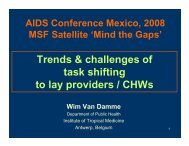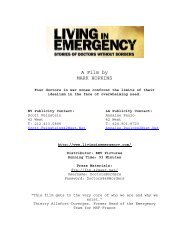Tuberculosis Diagnosis and Drug Sensitivity Testing
Tuberculosis Diagnosis and Drug Sensitivity Testing
Tuberculosis Diagnosis and Drug Sensitivity Testing
Create successful ePaper yourself
Turn your PDF publications into a flip-book with our unique Google optimized e-Paper software.
E Test<br />
Company<br />
In the FIND portfolio?<br />
Principle<br />
Stage of development<br />
Advantages<br />
Disadvantages<br />
Interest in peripheral<br />
laboratory settings?<br />
MB redox®<br />
Company<br />
In the FIND portfolio?<br />
Principle<br />
Stage of development<br />
Advantages<br />
Disadvantages<br />
Interest in peripheral<br />
laboratory settings?<br />
AB Biodisk (Sweden).<br />
No.<br />
10<br />
The technique is based on determination of drug sensitivity testing using strips<br />
containing gradients of impregnated antibiotics. The E Test strip is placed on the<br />
surface of the solid culture medium <strong>and</strong> MICs (minimal inhibitory concentrations, a<br />
measure of the susceptibility of a strain to an antibiotic) are determined by<br />
interpreting the point at which the ellipse of inhibition crosses the strip.<br />
Commercially available.<br />
Simplicity, minimal training required.<br />
Shown to be accurate <strong>and</strong> reproducible 15 .<br />
Relatively fast (five to ten days after primary culture).<br />
Requires high bacterial concentration for inoculum i.e. needs to start from a culture.<br />
Simple approach that does not require particular training of technical personnel.<br />
Requires an initial culture step, which significantly limits its advantages.<br />
Biotest (Germany).<br />
No.<br />
This system is based on the reduction of a tetrazolium salt indicator in liquid<br />
medium 16 . MB Redox® allows an easy macroscopic visualisation of the bacterial<br />
growth. The tetrazolium salt indicator forms red to violet particles when reduced by<br />
the growth of the mycobacteria.<br />
Commercially available.<br />
Simplified 96 well plate format, does not require specialised machine (can be read<br />
by eye or simple spectrophotometer).<br />
Cannot be used to measure DST on initially positive samples as dye is toxic;<br />
visualisation is not easy; very few reports available; relatively slow (16 days for a<br />
smear positive sample, 3 weeks for a negative result).<br />
Interest would seem to be limited as better-performing alternatives exist.





